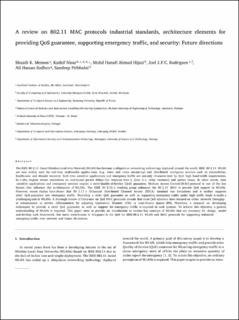| dc.contributor.author | Memon, Shuaib K. | |
| dc.contributor.author | Nisar, Kashif | |
| dc.contributor.author | Hijazi, Mohd Hanafi Ahmad | |
| dc.contributor.author | Chowdhry, B.S. | |
| dc.contributor.author | Sodhro, Ali Hassan | |
| dc.contributor.author | Pirbhulal, Sandeep | |
| dc.contributor.author | Rodrigues, Joel J.P.C. | |
| dc.date.accessioned | 2022-11-16T09:56:08Z | |
| dc.date.available | 2022-11-16T09:56:08Z | |
| dc.date.created | 2021-12-20T10:11:15Z | |
| dc.date.issued | 2021 | |
| dc.identifier.citation | Journal of Industrial Information Integration. 2021, 24 . | en_US |
| dc.identifier.issn | 2467-964X | |
| dc.identifier.uri | https://hdl.handle.net/11250/3032082 | |
| dc.description.abstract | The IEEE 802.11-based Wireless Local Area Network (WLAN) has become a ubiquitous networking technology deployed around the world. IEEE 802.11 WLAN are now widely used for real-time multimedia applications (e.g. voice and video streaming) and distributed emergency services such as telemedicine, healthcare, and disaster recovery. Both time-sensitive applications and emergency traffic are not only characterized by their high bandwidth requirements, but also impose severe restrictions on end-to-end packet delays (i.e. response time), jitter (i.e. delay variance) and packet losses. In other words, time-sensitive applications and emergency services require a strict Quality of Service (QoS) guarantee. Medium Access Control (MAC) protocol is one of the key factors that influence the performance of WLANs. The IEEE 802.11e working group enhanced the 802.11 MAC to provide QoS support in WLANs. However, recent studies have shown that 802.11e Enhanced Distributed Channel Access (EDCA) standard has limitations and it neither supports strict QoS guarantee nor emergency traffic. Providing a strict QoS guarantee as well as supporting emergency traffic under high traffic loads is really a challenging task in WLANs. A thorough review of literature on QoS MAC protocols reveals that most QoS schemes have focused on either network throughput enhancement or service differentiation by adjusting Contention Window (CW) or Inter-Frame Spaces (IFS). Therefore, a research on developing techniques to provide a strict QoS guarantee as well as support for emergency traffic is required in such systems. To achieve this objective, a general understanding of WLANs is required. This paper aims introduce various key concepts of WLANs that are necessary for design, model and develop such framework. Our main contribution in this paper is the QoS for IEEE 802.11 WLAN and MAC protocols for supporting industrial emergency traffic over network and future directions. | en_US |
| dc.language.iso | eng | en_US |
| dc.publisher | Elsevier | en_US |
| dc.rights | Attribution-NonCommercial-NoDerivatives 4.0 Internasjonal | * |
| dc.rights.uri | http://creativecommons.org/licenses/by-nc-nd/4.0/deed.no | * |
| dc.title | A survey on 802.11 MAC industrial standards, architecture, security & supporting emergency traffic: Future directions | en_US |
| dc.type | Peer reviewed | en_US |
| dc.type | Journal article | en_US |
| dc.description.version | acceptedVersion | en_US |
| dc.source.pagenumber | 0 | en_US |
| dc.source.volume | 24 | en_US |
| dc.source.journal | Journal of Industrial Information Integration | en_US |
| dc.identifier.doi | 10.1016/j.jii.2021.100225 | |
| dc.identifier.cristin | 1970391 | |
| cristin.ispublished | true | |
| cristin.fulltext | postprint | |
| cristin.qualitycode | 1 | |

